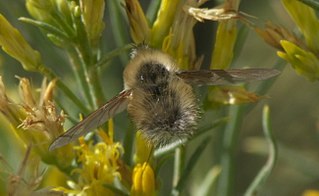
The Apioceridae, or flower-loving flies, are a small family of flies, all in the single genus Apiocera. They occur mostly in dry, sandy habitats in the deserts of North America, South America, and Australia. Other genera formerly placed in Apioceridae are now in Mydidae.
Androdioecy is a reproductive system characterized by the coexistence of males and hermaphrodites. Androdioecy is rare in comparison to the other major reproductive systems: dioecy, gynodioecy and hermaphroditism. In animals, androdioecy has been considered an important stepping stone in the transition from dioecy to hermaphroditism, and vice versa.

Diplogasterida was an order of nematodes. It was sometimes placed in a monotypic subclass Diplogasteria, but molecular phylogenetic evidence has shown it to be embedded in the family Rhabditidae. The confusion of having a hierarchical nesting of groups that were formerly mutually exclusive has led to a profusion of names. Although completely revised taxonomy of nematodes that builds on recent classification systems as well as recent phylogenetic evidence is still necessary, most contemporary taxonomic studies now treat all groups listed under "Diplogasterina" below as a single family, Diplogastridae.

The Pyrgotidae are an unusual family of flies (Diptera), one of only two families of Cyclorrhapha that lack ocelli. Most species are "picture-winged", as is typical among the Tephritoidea, but unlike other tephritoids, they are endoparasitoids; the females pursue scarab beetles in flight, laying an egg on the beetle's back under the elytra where the beetle cannot reach it. The egg hatches and the fly larva enters the body cavity of the beetle, feeding and eventually killing the host before pupating. In the United States, some species of Pyrgota and Sphecomyiella can be quite common in areas where their host beetles are abundant. Like their host beetles, these flies are primarily nocturnal, and are often attracted to artificial lights.

Merodon is a large genus of bee-like hoverflies. The majority of the species are centered on the Mediterranean and it is the second largest hoverfly genus in Europe with more than 50 European species. It is distributed over the Palaearctic and Afrotropical realms, with most European species occurring in Southern and Eastern Europe. The centre of distribution of this genus appears to be Turkey, where about 65 species have been recorded. Some species occur in Africa and the middle East, as far as Pakistan. Given the rate at which new species have been recorded over the past decades, the worldwide number of species could exceed 200. The larvae feed on the bulbs or rhizomes of monocotyledons.
Microtropesa is a genus of parasitic flies in the family Tachinidae. There are about 15 described species in Microtropesa.
Paratropeza is a genus of parasitic flies in the family Tachinidae. There are about 10 described species in Paratropeza.
Prodiaphania is a genus of parasitic flies in the family Tachinidae. There are about 17 described species in Prodiaphania.
Rutilotrixa is a genus of parasitic flies in the family Tachinidae. There are about seven described species in Rutilotrixa.
Micoletzkya is a genus of predatory bark-beetle-associated nematodes in the family Diplogastridae. The genus was named for the Austrian nematologist Henrich Micoletzky. As of 2013 it consists of 25 described species.

Pristionchus is a genus of nematodes (roundworms) in the family Diplogastridae that currently includes more than 50 described species. They are known mainly as non-parasitic associates of insects, especially beetles, while others have been reported from soil, organic matter, or rotting wood. The genus includes P. pacificus, a satellite model organism to the well-studied nematode Caenorhabditis elegans.
Sudhausia is a genus of nematodes (roundworms) of the family Diplogastridae. They live in association with dung beetles and are primarily known from Africa. Species of Sudhausia show a suite of biological features that, together, are unusual for nematodes and animals in general: hermaphrodites, which are females in form, mature to produce offspring before they are adults and thus even capable of mating, and their eggs grow in size during development. Hermaphrodites are also always live-bearing, which is unusual for nematodes under non-stressful conditions. The genus is named in honor of Walter Sudhaus, a German nematologist.
Levipalatum texanum is a free-living nematode (roundworm) in the family Diplogastridae. The species is androdioecious, consisting of self-fertile hermaphrodites, which are morphologically females, and males. It is known from the south-eastern United States and has been found to live in association with scarab beetles, although it has also been baited from soil. Nematodes of this species can be cultured on bacterium Escherichia coli in the laboratory, and they are presumed to also feed on microorganisms in the wild. Levipalatum is a monotypic genus.
Cytherea is a genus of bee flies.

Sergey Jacques Paramonov was a Soviet and Australian entomologist, specializing on flies (Diptera), of which described about 700 species and subspecies. Paramonov published over 185 scientific articles, some of which were published posthumously.
Aphoebantus is a genus of bee flies. There are at least 80 described species in Aphoebantus.

Ogcodes is a genus of small-headed flies in the family Acroceridae. About 90 species have been described for the genus.

Anastoechus is a genus of bee flies. There are at least 90 described species in Anastoechus.

Orthogonis is a genus of robber flies. There are about 14 described species in Orthogonis.

Allodiplogaster sudhausi is a free-living nematode species in the Diplogastridae family. It was described in 2008 as Koerneria sudhausi, before being moved to the genus Allodiplogaster in 2014. A. sudhausi is omnivorous. It predates on other nematodes, but can be cultured on Escherichia coli OP50 bacterium on agar.









